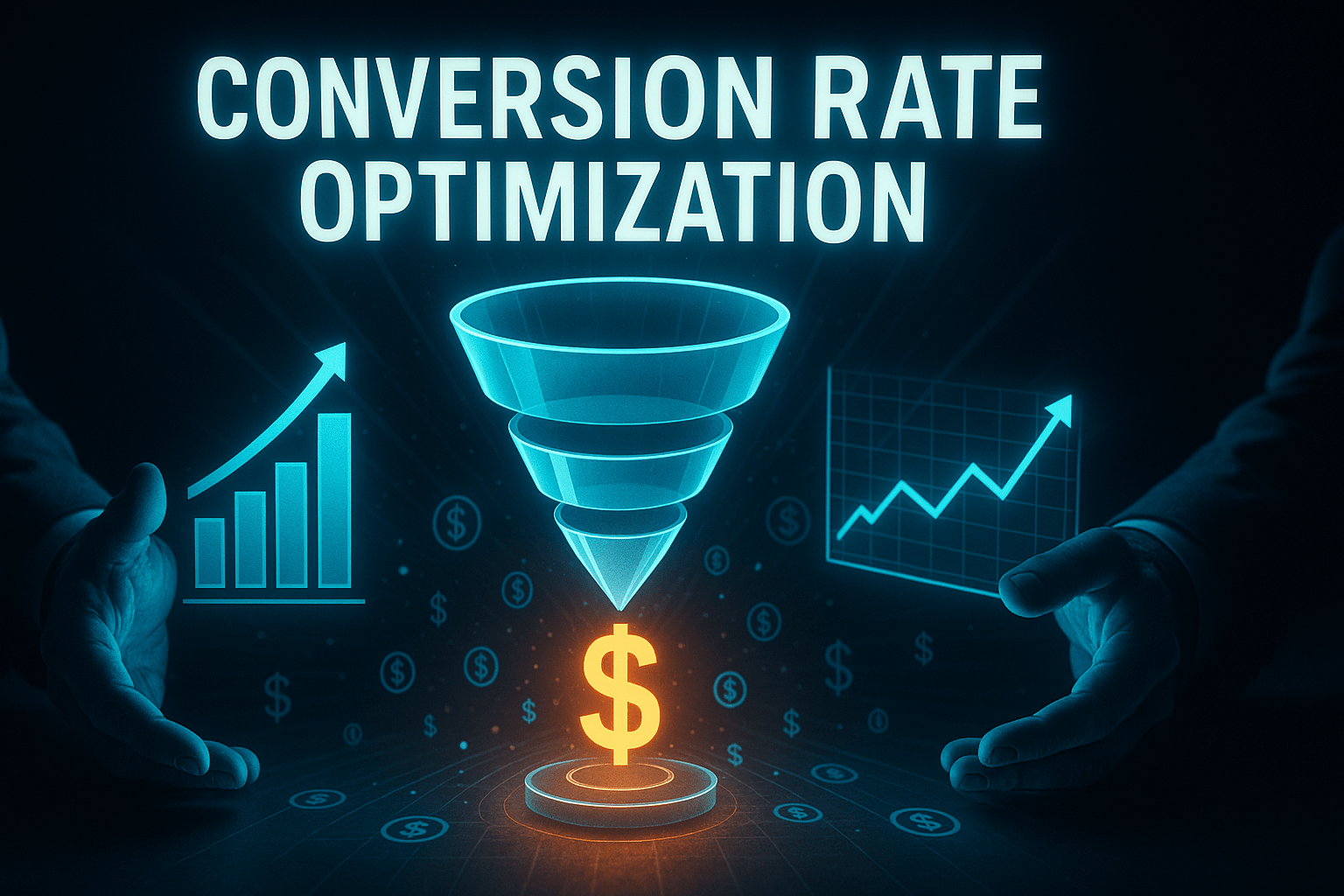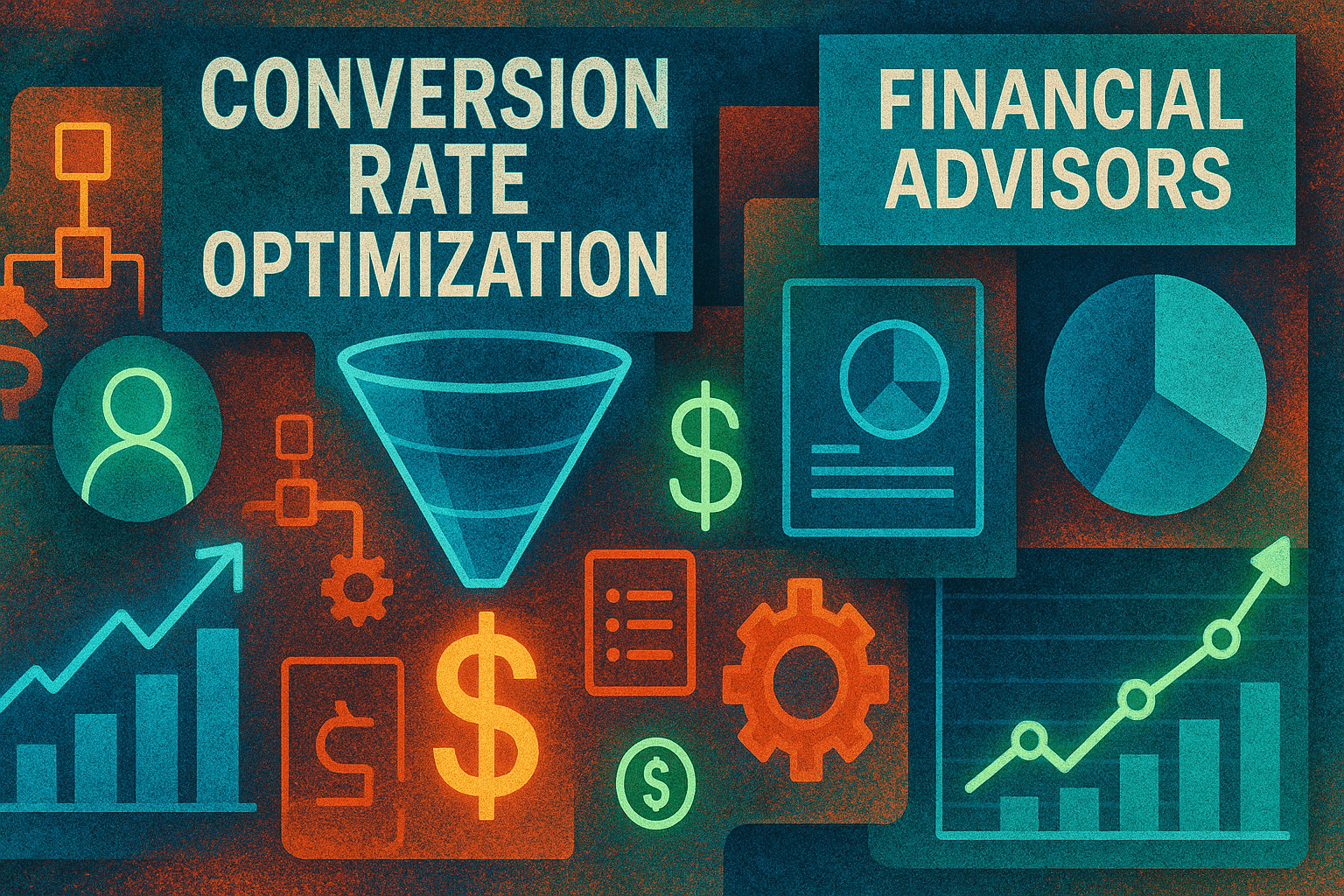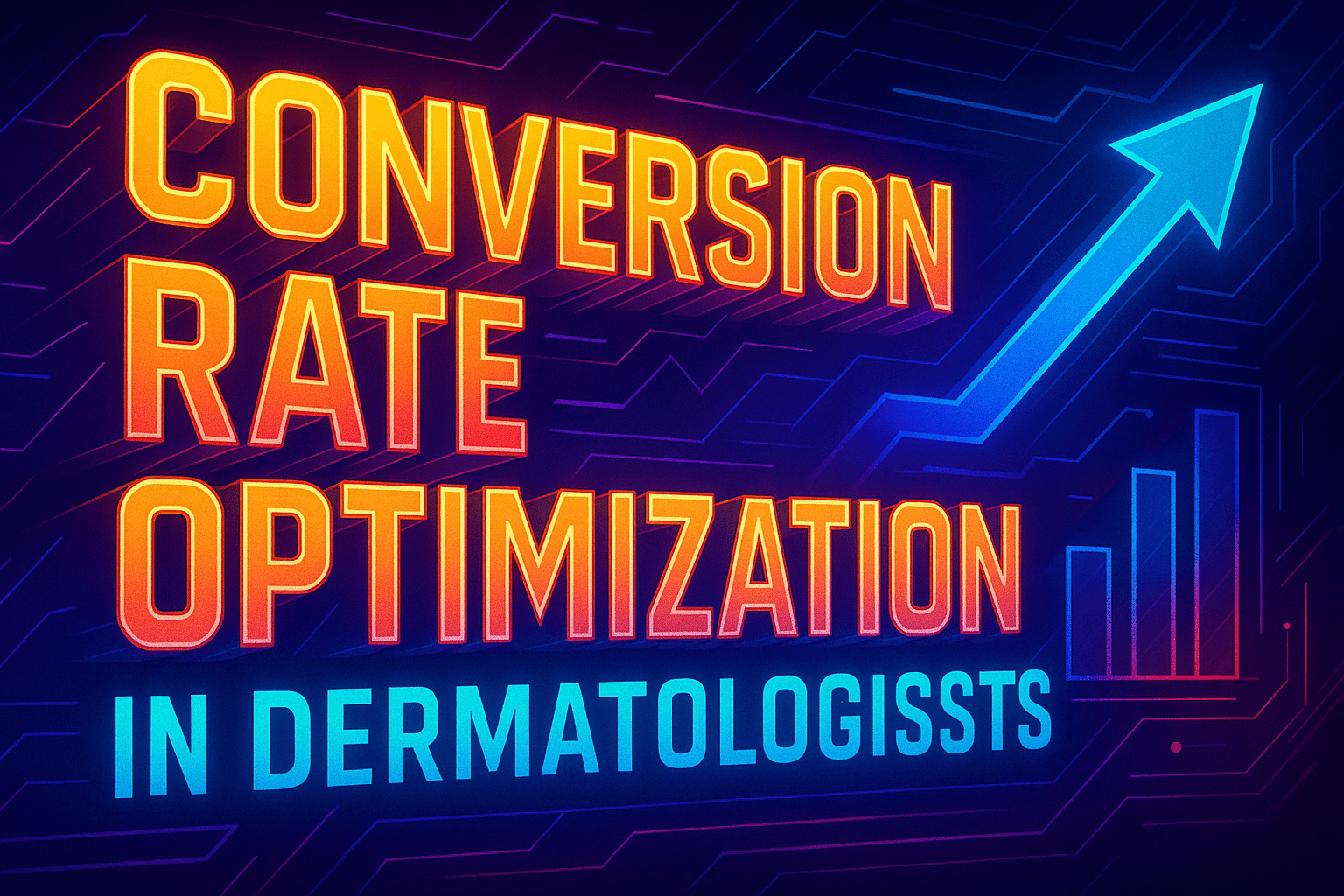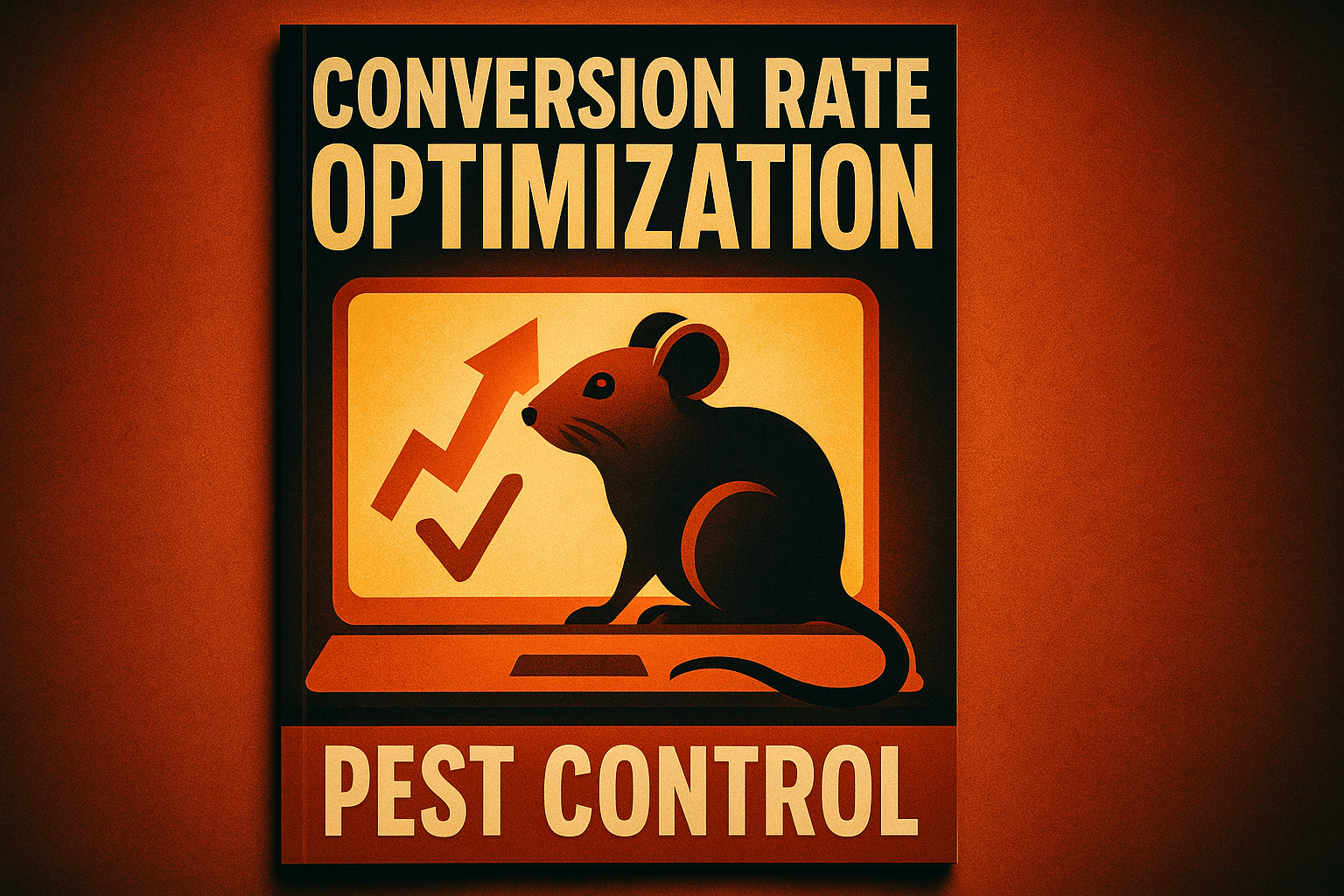Conversion Rate Optimization for Financial Advisors: Proven Strategies to Double Client Acquisitions
by Design Delulu Editorial · October 12, 2025

Smart, fast, and measurable. Here's how conversion rate optimization helps Financial Advisors win.
Every month, financial advisors invest thousands in marketing campaigns, SEO efforts, and paid advertising to attract potential clients. Yet most watch 95% of their website visitors leave without scheduling a consultation or requesting information. This represents not just lost opportunities, but wasted marketing dollars on traffic that never converts. The difference between thriving practices and struggling ones often isn't the volume of visitors they attract—it's what happens after those visitors arrive.
Conversion rate optimization for financial advisors matters because it transforms your existing traffic into qualified leads without increasing your ad spend. While competitors chase more clicks, strategic CRO practitioners focus on maximizing the value of visitors they already have. A modest 2% conversion rate improvement can mean dozens of additional qualified prospects annually, translating to millions in assets under management. In an industry where trust, credibility, and clarity determine client decisions, every element of your digital presence either builds confidence or creates friction. CRO identifies and eliminates those friction points systematically.

Why Financial Advisors Need Specialized Conversion Rate Optimization
Financial advisory services face unique conversion challenges that generic CRO approaches fail to address. Unlike e-commerce sites with instant purchases, financial advisors navigate extended consideration cycles, complex decision-making processes, and heightened trust requirements. Prospective clients research multiple advisors, compare credentials exhaustively, and often consult family members before committing. Your conversion funnel must account for this complexity while addressing compliance requirements and maintaining professional credibility.
The stakes are considerably higher in financial services. A single converted client can represent hundreds of thousands in lifetime value, making optimization efforts exponentially more valuable than in other industries. However, this also means prospects approach with greater skepticism and higher expectations. They scrutinize every credential, testimonial, and value proposition. Your website must answer unspoken questions about trustworthiness, expertise, and cultural fit before visitors will even consider scheduling that initial consultation.
Traditional CRO tactics often backfire in financial services. Aggressive popups, countdown timers, and scarcity messaging undermine the professional authority advisors need to project. Compliance regulations restrict certain claims and testimonial formats. Your target audience—typically affluent individuals approaching retirement or business owners seeking wealth management—responds to sophistication, transparency, and demonstrated expertise rather than typical marketing pressure tactics. Effective conversion rate optimization for financial advisors requires strategies calibrated specifically to these dynamics.
Core Components of High-Converting Financial Advisory Websites
Successful conversion optimization begins with understanding what drives financial advisory prospects toward commitment. Trust indicators form the foundation: visible credentials, regulatory disclosures, professional affiliations, and authentic client testimonials. But these elements must be strategically positioned where doubt typically emerges in the visitor journey. Testing reveals that placement matters as much as presence—credentials buried in footers convert poorly compared to contextual positioning near consultation requests.
Value proposition clarity separates converting sites from digital brochures. Prospects need immediate understanding of your specialization, ideal client profile, and differentiation from competitors. Vague language about "comprehensive financial planning" fails to compel action. Instead, specificity drives conversions: "retirement income strategies for corporate executives transitioning from stock-heavy compensation" or "tax-efficient wealth transfer planning for multi-generational family businesses." This precision helps qualified prospects self-identify while filtering mismatched inquiries.
The consultation request process itself requires optimization. Multi-step forms with 15+ fields create abandonment. Yet oversimplified forms generate unqualified leads that waste advisor time. The optimal balance varies by practice, requiring systematic testing. Successful approaches often include optional qualifying questions, calendar integration for immediate scheduling, and clear communication about what happens next. Removing uncertainty from the process—how long will the consultation last, what should prospects prepare, when will they hear back—demonstrably improves conversion rates.
Strategic Testing Framework for Financial Advisors
Effective CRO operates through structured experimentation rather than guesswork. The process begins with conversion funnel analysis identifying where prospects abandon their journey. Analytics reveal whether visitors struggle at the homepage, service description pages, or consultation forms. Heatmaps show which content captures attention and which sections get ignored. Session recordings expose usability frustrations—confusing navigation, unclear calls-to-action, or mobile experience problems that desktop testing misses.
Hypothesis development translates these insights into testable improvements. Rather than redesigning everything simultaneously, strategic CRO isolates variables for measurement. One experiment might test whether case study placement on the homepage improves consultation requests. Another compares consultation form lengths. A third evaluates whether video introductions from advisors increase trust and conversion compared to static photos. Each test produces actionable data that compounds into significant conversion improvements over time.
Prioritization determines testing sequence based on potential impact and implementation complexity. High-traffic pages with poor conversion rates warrant immediate attention. Quick wins—button color changes, headline rewrites, navigation simplifications—build momentum while more complex experiments progress through development. The testing roadmap should balance immediate improvements with longer-term strategic optimizations like complete page redesigns or new conversion pathways for different prospect segments.

Message Optimization for Financial Services Audiences
Financial advisory prospects respond to different messaging based on their specific needs and life stages. Comprehensive message testing reveals which value propositions resonate with different audience segments. Pre-retirees concerned about market volatility respond to messages emphasizing risk management and income certainty. Business owners prioritize tax efficiency and succession planning. Young professionals focus on goal planning and portfolio growth. Generic messaging attempting to appeal to everyone typically converts poorly across all segments.
Social proof requires careful calibration in financial services. Specific outcome claims face regulatory restrictions, but process testimonials, relationship descriptions, and advisor approach endorsements remain powerful. Testing reveals that authenticity trumps polish—real client quotes with normal language convert better than heavily edited corporate testimonials. Video testimonials typically outperform text, but only when production quality suggests professionalism without appearing staged. Client names with titles and locations add credibility, though privacy considerations may limit this approach for high-net-worth clients.
Educational content serves dual purposes: demonstrating expertise while moving prospects toward conversion. Blog posts addressing specific financial concerns attract organic search traffic, but conversion optimization ensures this content guides readers toward consultation requests. Strategic placement of relevant calls-to-action, contextual consultation offers tied to content topics, and progressive profiling that captures contact information in exchange for advanced resources all contribute to converting educational browsers into qualified leads.
Technical Optimization for Financial Advisory Conversions
Page speed dramatically impacts conversion rates, particularly for the affluent audiences financial advisors typically target. Research indicates that 53% of mobile visitors abandon sites taking longer than three seconds to load. For financial advisory sites heavy with credential badges, security seals, and professional photography, optimization becomes critical. Image compression, lazy loading, content delivery networks, and code minimization all contribute to faster experiences that prevent prospect abandonment before engagement even begins.
Mobile optimization extends beyond responsive design. Financial prospects increasingly research advisors during commutes, between meetings, or while comparing options away from their desks. Mobile conversion rates typically lag desktop by 30-50%, but this gap narrows with proper optimization. Click-to-call buttons, simplified mobile navigation, reduced form fields for smaller screens, and mobile-specific content prioritization all improve conversion performance. Testing mobile experiences on actual devices reveals issues desktop emulators miss.
Security and compliance elements require careful implementation. Prospects expect to see security indicators—SSL certificates, privacy policies, regulatory disclosures—but poorly integrated compliance elements create visual clutter and confusion. Strategic positioning ensures regulatory requirements are met without overwhelming visitors. Privacy-focused analytics, compliant lead capture forms, and clear data handling explanations build the trust necessary for prospects to share sensitive financial information during consultation requests.
Advanced Personalization Strategies
Sophisticated CRO leverages behavioral data to personalize visitor experiences without sacrificing privacy or professionalism. Returning visitors see different messaging than first-time browsers. Prospects arriving from retirement planning content receive retirement-focused value propositions and consultation offers. Visitors from business valuation articles see messaging emphasizing business owner services. This contextual relevance increases conversion likelihood by demonstrating understanding of specific visitor needs and concerns.
Geographic targeting serves financial advisors particularly well, especially those operating within specific service areas or building regional presence. Visitors from target ZIP codes see localized messaging, area-specific testimonials, and community involvement highlights. This local relevance particularly matters for advisors competing against national firms by emphasizing accessibility, community knowledge, and personalized service. Testing typically shows 15-40% conversion rate improvements from geographic personalization alone.
Retargeting strategies bring prospects back after initial visits. Financial advisory decisions rarely occur during first website interactions. Strategic retargeting keeps advisors top-of-mind during the consideration period through educational content, webinar invitations, newsletter subscriptions, and consultation reminders. The key lies in providing value rather than just repeating consultation requests—prospects need reasons to return beyond simple repetition of the same call-to-action that didn't convert initially.
Measurement and Continuous Improvement
Effective conversion rate optimization requires rigorous measurement beyond simple conversion counting. Attribution modeling reveals which marketing channels generate the highest-quality leads and best conversion rates. Advisors often discover that certain traffic sources—particular keywords, referral partners, or content topics—convert at multiples of others. This intelligence informs not just website optimization but entire marketing strategy adjustments that compound conversion improvements.
Leading indicators predict conversion success before prospects reach consultation forms. Metrics like time on site, pages per session, return visitor rates, and engagement with specific content types all correlate with eventual conversion likelihood. Monitoring these indicators enables proactive optimization—if visitors from certain sources show strong engagement but poor conversion, the barrier likely exists at the consultation request stage rather than earlier in the journey. This diagnostic approach directs optimization efforts efficiently.
Long-term tracking connects website conversions to actual client acquisitions and revenue. Not all leads convert to clients at equal rates, and consultation request volume alone misleads without quality assessment. Integration between website analytics, CRM systems, and practice management software reveals which conversion optimization efforts generate not just more leads, but better clients. This closed-loop analysis ensures CRO investments deliver actual practice growth rather than just metrics improvements.

Implementation Roadmap
Successful CRO programs follow structured implementation approaches rather than scattered tactics. The initial discovery phase establishes baseline conversion rates, identifies primary conversion barriers, and prioritizes optimization opportunities. Comprehensive audits examine user experience, messaging effectiveness, technical performance, and competitive positioning. This foundation ensures subsequent optimization efforts address actual barriers rather than assumed problems.
The blueprint phase designs the testing roadmap, measurement framework, and success criteria. Prioritized experiments receive detailed specifications—what will be tested, how success will be measured, what resources are required, and how results will be implemented. This planning prevents the common CRO pitfall of endless testing without strategic direction. Clear hypotheses, statistical significance thresholds, and implementation commitments ensure experiments produce actionable improvements rather than just interesting data.
Execution proceeds through rapid testing cycles with systematic learning capture. Each experiment generates insights beyond simple win/loss outcomes. Failed tests reveal what doesn't resonate with prospects, informing future experiments. Unexpected results prompt deeper investigation into prospect behavior and preferences. Successful optimizations scale across similar pages and become standardized practices. This systematic approach compounds learning and results over time, distinguishing strategic CRO from reactive tinkering.
Common Pitfalls and How to Avoid Them
Many financial advisors approach conversion optimization with unrealistic expectations or counterproductive strategies. The most common mistake involves testing too many variables simultaneously, making it impossible to identify which changes drove results. Controlled experiments isolating specific variables generate actionable intelligence. Wholesale redesigns produce uncertain attribution and often regress conversion rates despite appearing more modern or attractive.
Insufficient traffic volume undermines testing validity. Experiments require adequate sample sizes to reach statistical significance—typically thousands of visitors per variation. Advisors with modest traffic should focus on high-impact tests rather than minor tweaks unlikely to generate measurable results. Alternatively, extending test duration ensures adequate data collection, though this slows optimization velocity. Understanding these constraints prevents premature conclusions from insufficient data.
Ignoring qualitative feedback creates blind spots in optimization strategy. Analytics reveal what happens but not why. Prospect surveys, consultation feedback, and direct conversations expose conversion barriers invisible in data. Common examples include concerns about fee structures, uncertainty about service scope, or simple confusion about next steps. Addressing these qualitative insights often produces larger conversion improvements than purely data-driven optimizations.
Frequently Asked Questions
Let’s level up your Financial Advisors business
Need services that actually move the needle for Financial Advisors? See our approach, pricing, and timelines—then book a quick call.
Additional Resources
- Schedule Your Strategy Call
Book a complimentary 30-minute consultation to discuss your current conversion challenges, review your analytics, and receive preliminary recommendations. We'll assess your optimization opportunities and outline a customized testing roadmap tailored specifically to your financial advisory practice.
- View Our Portfolio
Explore successful conversion rate optimization projects we've delivered for financial advisors and wealth management firms. See real-world examples of homepage redesigns, consultation form optimizations, and complete digital experience transformations that doubled and tripled qualified lead generation.
- Access Free CRO Tools
Download our free conversion rate optimization toolkit for financial advisors, including heatmap analysis templates, A/B test planning worksheets, conversion funnel audit checklists, and ROI calculators. Start identifying quick-win optimization opportunities before investing in comprehensive programs.
Related Reading

Proven conversion rate optimization strategies for dermatology practices. Increase patient bookings with A/B testing, landing page optimization, and data-driven improvements.

Maximize pest control leads with proven conversion rate optimization. Get A/B testing, landing page optimization, and data-driven strategies that increase bookings.
